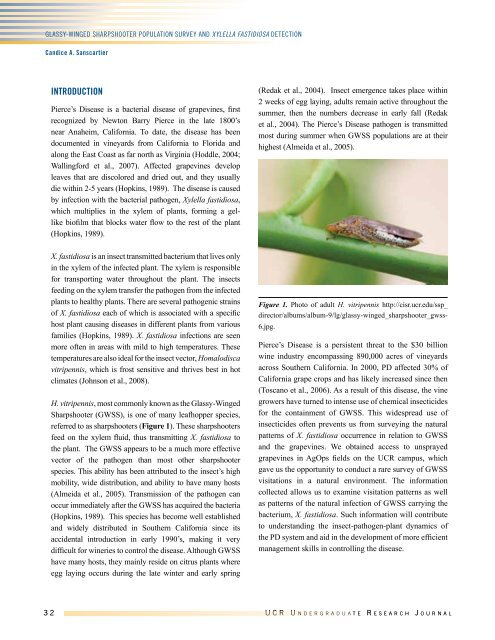Undergraduate Research Journal
Undergraduate Research Journal
Undergraduate Research Journal
You also want an ePaper? Increase the reach of your titles
YUMPU automatically turns print PDFs into web optimized ePapers that Google loves.
Glassy-Winged Sharpshooter Population Survey and Xylella fastidiosa Detection<br />
Candice A. Sanscartier<br />
Introduction<br />
Pierce’s Disease is a bacterial disease of grapevines, first<br />
recognized by Newton Barry Pierce in the late 1800’s<br />
near Anaheim, California. To date, the disease has been<br />
documented in vineyards from California to Florida and<br />
along the East Coast as far north as Virginia (Hoddle, 2004;<br />
Wallingford et al., 2007). Affected grapevines develop<br />
leaves that are discolored and dried out, and they usually<br />
die within 2-5 years (Hopkins, 1989). The disease is caused<br />
by infection with the bacterial pathogen, Xylella fastidiosa,<br />
which multiplies in the xylem of plants, forming a gellike<br />
biofilm that blocks water flow to the rest of the plant<br />
(Hopkins, 1989).<br />
(Redak et al., 2004). Insect emergence takes place within<br />
2 weeks of egg laying, adults remain active throughout the<br />
summer, then the numbers decrease in early fall (Redak<br />
et al., 2004). The Pierce’s Disease pathogen is transmitted<br />
most during summer when GWSS populations are at their<br />
highest (Almeida et al., 2005).<br />
X. fastidiosa is an insect transmitted bacterium that lives only<br />
in the xylem of the infected plant. The xylem is responsible<br />
for transporting water throughout the plant. The insects<br />
feeding on the xylem transfer the pathogen from the infected<br />
plants to healthy plants. There are several pathogenic strains<br />
of X. fastidiosa each of which is associated with a specific<br />
host plant causing diseases in different plants from various<br />
families (Hopkins, 1989). X. fastidiosa infections are seen<br />
more often in areas with mild to high temperatures. These<br />
temperatures are also ideal for the insect vector, Homalodisca<br />
vitripennis, which is frost sensitive and thrives best in hot<br />
climates (Johnson et al., 2008).<br />
H. vitripennis, most commonly known as the Glassy-Winged<br />
Sharpshooter (GWSS), is one of many leafhopper species,<br />
referred to as sharpshooters (Figure 1). These sharpshooters<br />
feed on the xylem fluid, thus transmitting X. fastidiosa to<br />
the plant. The GWSS appears to be a much more effective<br />
vector of the pathogen than most other sharpshooter<br />
species. This ability has been attributed to the insect’s high<br />
mobility, wide distribution, and ability to have many hosts<br />
(Almeida et al., 2005). Transmission of the pathogen can<br />
occur immediately after the GWSS has acquired the bacteria<br />
(Hopkins, 1989). This species has become well established<br />
and widely distributed in Southern California since its<br />
accidental introduction in early 1990’s, making it very<br />
difficult for wineries to control the disease. Although GWSS<br />
have many hosts, they mainly reside on citrus plants where<br />
egg laying occurs during the late winter and early spring<br />
Figure 1. Photo of adult H. vitripennis http://cisr.ucr.edu/ssp_<br />
director/albums/album-9/lg/glassy-winged_sharpshooter_gwss-<br />
6.jpg.<br />
Pierce’s Disease is a persistent threat to the $30 billion<br />
wine industry encompassing 890,000 acres of vineyards<br />
across Southern California. In 2000, PD affected 30% of<br />
California grape crops and has likely increased since then<br />
(Toscano et al., 2006). As a result of this disease, the vine<br />
growers have turned to intense use of chemical insecticides<br />
for the containment of GWSS. This widespread use of<br />
insecticides often prevents us from surveying the natural<br />
patterns of X. fastidiosa occurrence in relation to GWSS<br />
and the grapevines. We obtained access to unsprayed<br />
grapevines in AgOps fields on the UCR campus, which<br />
gave us the opportunity to conduct a rare survey of GWSS<br />
visitations in a natural environment. The information<br />
collected allows us to examine visitation patterns as well<br />
as patterns of the natural infection of GWSS carrying the<br />
bacterium, X. fastidiosa. Such information will contribute<br />
to understanding the insect-pathogen-plant dynamics of<br />
the PD system and aid in the development of more efficient<br />
management skills in controlling the disease.<br />
3 2 U C R U n d e r g r a d u a t e R e s e a r c h J o u r n a l














